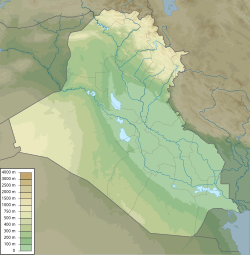
Back معركة القادسية Arabic Qadisiyyə döyüşü Azerbaijani قادسیه دؤیوشو AZB Битка при Кадисия Bulgarian কাদিসিয়ার যুদ্ধ Bengali/Bangla Bitka kod El-Kadisije BS Batalla d'al-Qadisiyya Catalan Schlacht von al-Qādisīya German Batalla de al-Qadisiyya Spanish نبرد قادسیه Persian
This article includes a list of general references, but it lacks sufficient corresponding inline citations. (January 2024) |
| Battle of al-Qadisiyyah | |||||||||
|---|---|---|---|---|---|---|---|---|---|
| Part of the Muslim conquest of Persia | |||||||||
 Depiction of the battle from a manuscript of the Persian epic Shahnameh, 1614 | |||||||||
| |||||||||
| Belligerents | |||||||||
| Rashidun Caliphate | Sasanian Empire | ||||||||
| Commanders and leaders | |||||||||
| Units involved | |||||||||
| Rashidun army | Sasanian army | ||||||||
| Strength | |||||||||
| 30,000[5] | |||||||||
| Casualties and losses | |||||||||
| Heavy[6] | Heavy[6] | ||||||||
Location within modern-day Iraq | |||||||||
The Battle of al-Qadisiyyah[a] (Arabic: مَعْرَكَة ٱلْقَادِسِيَّة Maʿrakat al-Qādisīyah; Persian: نبرد قادسیه Nâbārd-e Qâdisiyeh) took place between the Rashidun Caliphate and the Sasanian Empire in November 636. It resulted in a decisive victory for the Rashidun army and is considered to be one of the most significant engagements of the Muslim conquest of Persia, and thereby of the early Muslim conquests as a whole. After losing al-Qadisiyyah, the Sasanian army was left unable to defend against the Rashidun siege of Ctesiphon, thus being forced to retreat from all of Mesopotamia. This development enabled further Rashidun offensives into the Persian mainland and culminated in the Sasanian Empire's annexation by 651.
It is widely believed that the Rashidun army's advance on al-Qadisiyyah began on 16 November 636 and continued for the next three days. During the battle, Sasanian troops were thrown into disarray following the death of their general Rostam Farrokhzad under uncertain circumstances. The ensuing collapse of their positions marked a cataclysmic defeat that led to the Rashidun army's seizure of Ctesiphon, which had served as the Persian capital city since the Parthian period.[7]
The Rashidun Caliphate's success in capturing al-Qadisiyyah was key to conquering the Sasanian province of Asoristan, and was followed by major engagements at Jalula and Nahavand. The battle allegedly saw the establishment of an alliance between the Sasanian Empire and the Byzantine Empire.[citation needed] This purported alliance, for the Byzantines, was motivated by the contemporary Rashidun invasion of the Levant and Egypt.
In 2024, scholars and researchers from Durham University and the University of al-Qadisiyyah identified the likely site of the battle to an open field situated approximately 19 kilometres (12 mi) to the south of modern-day Kufa.[8][9]
- ^ Crawford 2013, p. 138.
- ^ Pourshariati 2011, p. 157.
- ^ Pourshariati 2011, pp. 232–233, 269.
- ^ a b Pourshariati 2011, pp. 232–233.
- ^ Dupuy & Dupuy 1996, p. 249.
- ^ a b Morony 1986.
- ^ Lewental 2014.
- ^ "Archaeologists identify centuries-old battle site in Iraq using declassified spy satellite images". CNN.
- ^ "Declassified US Spy Satellite Images Reveal Ancient Battle Site". Newsweek.
Cite error: There are <ref group=lower-alpha> tags or {{efn}} templates on this page, but the references will not show without a {{reflist|group=lower-alpha}} template or {{notelist}} template (see the help page).
© MMXXIII Rich X Search. We shall prevail. All rights reserved. Rich X Search
